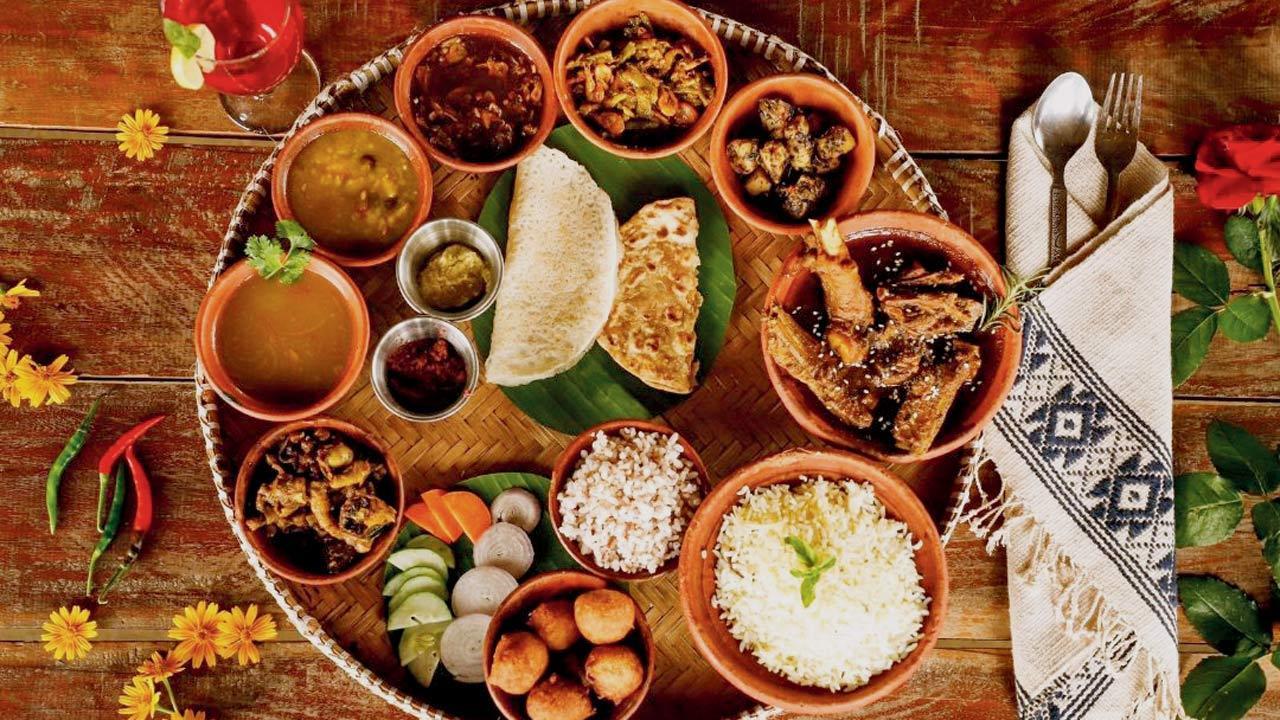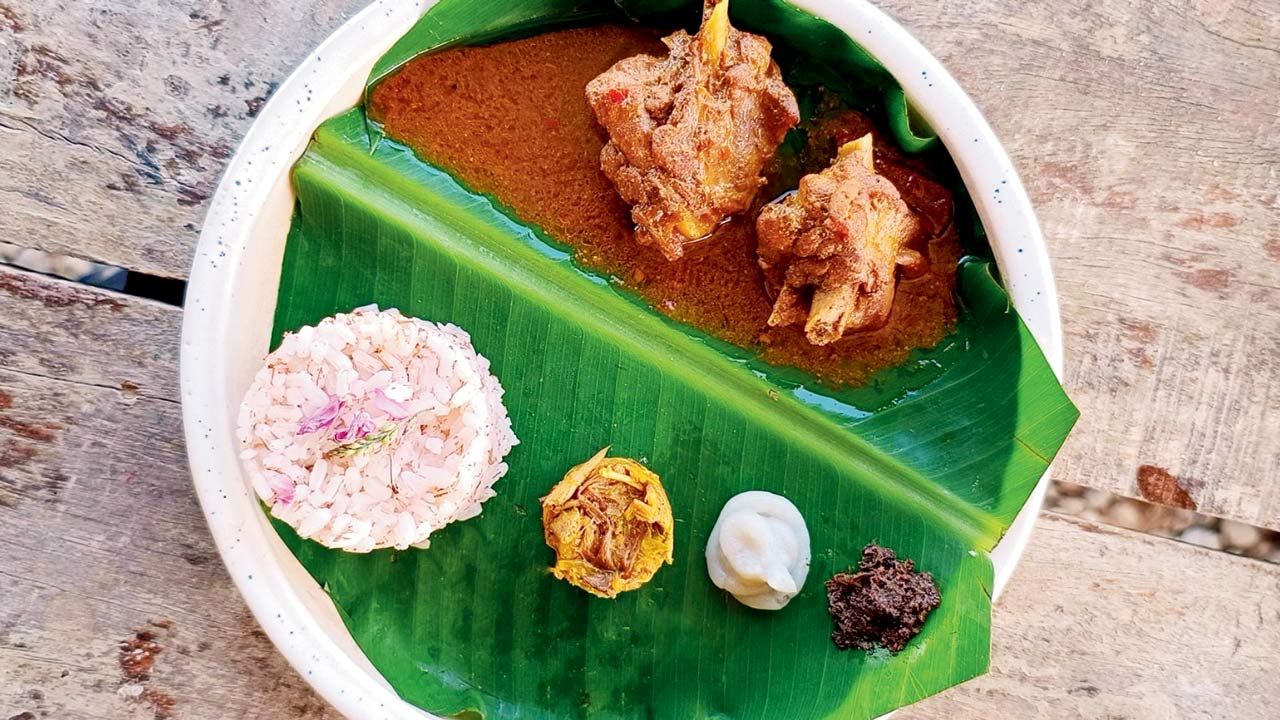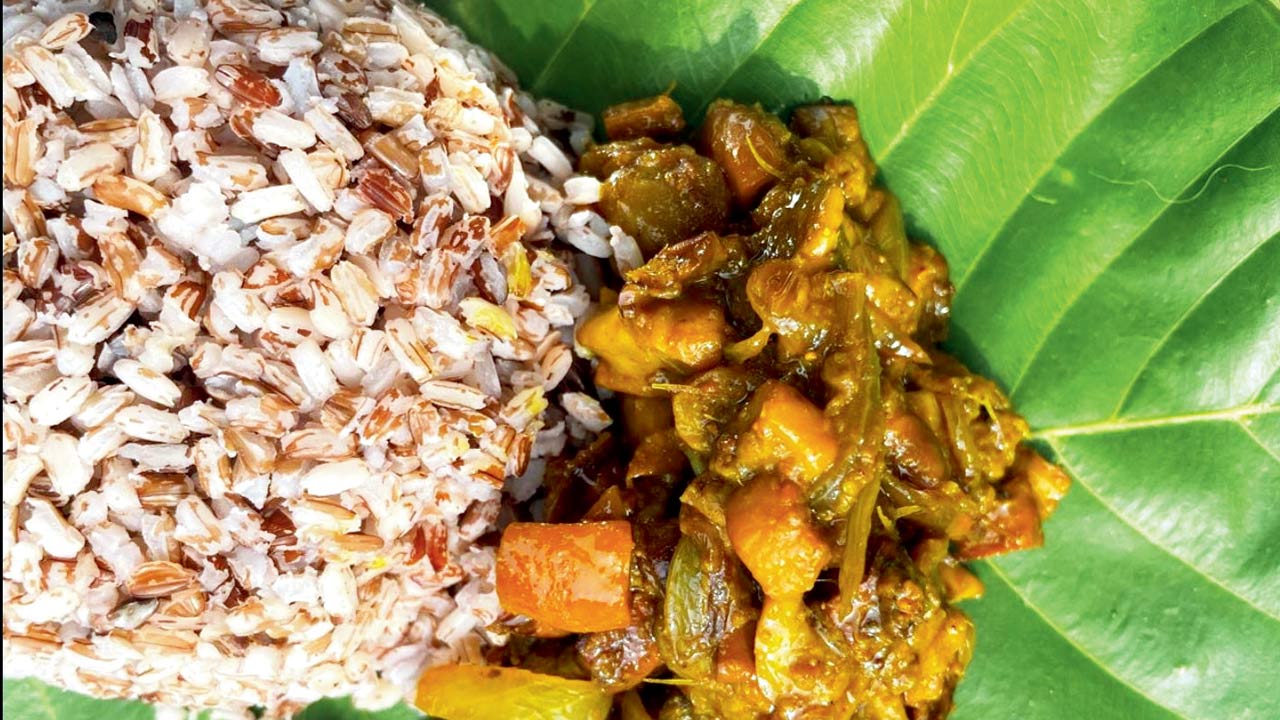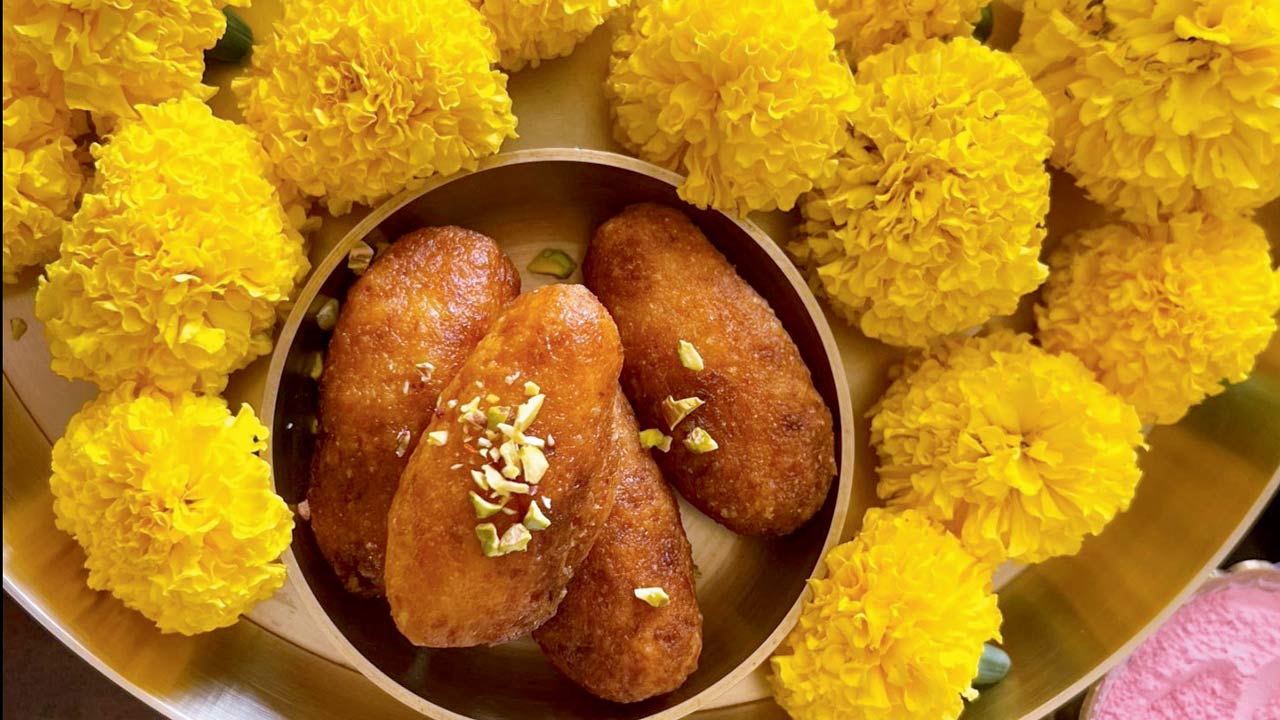Jharkhandi cuisine is a rich tapestry of outside cultural influences and indigenous foods. Sunday mid-day explores this unique amalgamation through the perspectives of those who call the state home

This traditional Jharkhandi thali at The Open Fields, Ghasibari, has madwa roti, chilka roti (center). Starting from the salad, clockwise, katnausi (chana and mutton innards), phutkal maadh jhol (starch of brown rice cooked with dehydrated herbs), aloo chana sabzi, sunai manchurian, chingri machli sabzi, (river shrimp with seasonal veggies), aloo kanda saag, desi mutton curry, sonachur rice, goda chawal, and gulgula (brown balls). There is kathal (jackfruit) ki chutney and kudrum (gongura) chutney.
Growing up in a typical Goan family in Mumbai, Michelle Fernandes’ mother ensured her children stayed connected to their roots, especially through food. This instilled in Fernandes a love for cooking, where she made some of the best fish curries and tea cakes that everyone raved about. Little did she know that her marriage to a Dhanbad-based entrepreneur would have her move to the coal capital of India and set her on a roller coaster of changes—in culture, food, place, and language. Going from xith kodi (fish curry) to dal, bhat, bhujia (vegetable sautéed in mustard oil) took some getting used to, but her love for cooking kept her curious enough to explore a cuisine that has a strong influence from the bordering states of Bihar, UP, Chattisgarh, Odisha, and West Bengal. Think posto (poppy seeds), mangrela (onion seeds) and leela sarson (mustard flavour, not for the faint-hearted).

This thali includes desi chicken curry, demta pickle (Pickled red ant chutney), kinda (sweet potato mash), phutkal (new leaves of ficus tree) and goda chawal (local brown rice).
Fernandes instantly took a liking to dhuska (deep-fried savoury bread) and ghugni (peas or chickpeas savoury), thekua (an Indo-Nepalese cookie), pua (pancakes), litti chokha (a Bihari delicacy of stuffed and baked whole wheat dough balls served with a veggie mash) and gulgulas (deep-fried sweets). “I have been often surprised and delighted by the depth and diversity of Jharkhand’s cuisine—from indigenous ingredients to tribal food, I learn something new everyday,” says Fernandes.
Born in Bihar and raised in Jharkhand, Instagrammer Shivangi Dubey promotes cuisines from both states on social media. On November 15, 2000, Jharkhand was carved out of Bihar. “For a large part of my childhood, the lines between Bihari and Jharkhandi food were blurred, and beyond a couple of other recipes, I hardly knew much,” says Dubey. “I am still discovering so much. It’s rich in flavours but uses simple fuss-free ingredients.” Dubey feels that not much is spoken about the state’s cuisine due to economic factors and infrastructure development, which directly impact tourism and perception of the state.

Jamun kukri with red rice
Her favourites are chilka roti, maad jhor, and dhuska. “Chilka roti is special because when I moved to Ranchi, I was living in a hostel, and my friend Pooja would often invite me over to her place and feed me Jharkhandi dishes,” says Dubey. “So it reminds me of my precious friendship and the comfort I sought through food in a new city.” She shares how rice and chana dal are soaked and ground with ginger and green chillies to make a dosa-like batter. “You can eat these with anything,” she says.
Inspired by the villagers in Leh who showcased their culture to tourists, a pilot-doctor couple, Dr Manisha and Kumar Abhishek Oraon, started a rose plantation in Ghasibari in 2018, which they expanded during COVID into The Open Field, along with co-founder Prateek Toppo. It focuses on education, experiential learning, workshops, farm-to-table dining, and interactive sessions about tribal foods.

Thekua and Chilka Roti
“We wanted to preserve and promote Jharkhand’s rich cultural heritage and culinary traditions,” says Dr Oraon, adding, “We observed the rapid disappearance of traditional practices and ingredients due to modernisation and climate change. We wanted to create a platform to celebrate our food and support farmers and artisans by intertwining agro-tourism with cultural preservation to let visitors appreciate tribal cuisine while contributing to the local economy.”
Abhishek adds, “People often view Jharkhand’s tribal food as unsophisticated or unappealing. To overcome these misconceptions, we showcase the stories and flavours behind each dish, highlighting their significance and appeal. Our initiatives empower local farmers and artisans, creating economic and social benefits.”
Toppo emphasises the unique aspects of Jharkhand’s tribal cuisine, such as its rich flavours derived from various spices, herbs, and cooking techniques. “These foods are not only delicious but also nutritious. They are made from local, organic ingredients, employing traditional methods like dehydration and fermentation, and provide a balanced diet. Many recipes are simple and can be adapted to modern kitchens,” he adds.
Abhishek highlights how mahua flowers are integral to Jharkhand’s tribal communities. They are used in syrups, purees, liquor, and medicinal extracts and are served in ceremonies and weddings. Mahua flowers provide vitamins, proteins, minerals, and fats, and expectant mothers consume mahua chutney for nutritional benefits. Mahua kheer is everyone’s favourite. Another dish he mentions is made from red ants, their eggs, and larvae, which are rich in Vitamin C. “It reflects the state’s resourcefulness and deep connection to nature. However, it faces habitat loss and environment change challenges and deserves our attention for conservation,” he concludes.
Dhuska and ghugni

Dhuska
Ingredients
1 cup rice
1/2 cup chana dal
1/4 cup urad dal soaked for
6-8 hours or overnight
1 tbsp jeera
1 tsp salt
Method
Grind rice and dals with jeera, salt, and very little water into a fine paste. Let it sit for a couple of hours, then deep fry on medium heat using a flat spoon as a base. Fry till golden brown.
Ghugni
Ingredients
1 cup black chana, soaked overnight
2 potatoes, peeled
1 medium-sized onion
2 tomatoes
3-4 green chillies
2-3 tbsp mustard oil
1 tsp jeera
1 tsp jeera powder
1 tsp dhania powder
1/2 tsp haldi
1/2 tsp red chilli powder
1/4 tsp garam masala powder
6-7 cloves of garlic
1/4 tsp baking soda
1 tsp salt
Chopped coriander
Method
Pressure cook chana and potatoes with salt and baking soda in two cups of water for up to five to six whistles. Remove pressure and keep aside.
Heat two to three tablespoons of mustard oil in a kadhai. Add jeera, onions, and chillies, and sauté. Follow this with powdered spices. Blend tomatoes and garlic into a fine paste and add to the masala. Sauté until the masala is well roasted and the oil leaves the sides. Add boiled chana and potatoes (mashed by hand). Season and let simmer for 10 minutes. Garnish with coriander and serve with hot dhuskas.
Dudhauri

Ingredients
1/2 cup short-grain rice
1 1/2 cups milk
Oil for frying
Method
Boil milk in a kadhai. Take half the short-grain rice and boil it with the milk until the mixture dries up. Let this cool down, then grind and knead into a dough. If the mixture is soggy, add a bit of rice flour. Give it a cylindrical shape and freeze for a couple of minutes. Heat oil/ghee in a pan and fry the balls on low flame. Prepare a syrup of water, sugar, and kesar. The quantity of water should be twice that of the sugar. Dip the balls directly into chaasni after frying for 15 minutes and serve warm!
Demta chutney
250 gm red ants
5-6 cloves of garlic
2-3 green chillies
1 chopped onion
2 tbsp oil (preferably mustard)
Salt to taste

Michelle Fernandes and Shivangi Dubey
Method
Wash the ants, eggs, and larvae thoroughly, and drain the water. Grind them together in a mortar and pestle with garlic and green chillies. Heat some oil in a pan over medium heat. Add chopped onions and sauté until brown. Add the ground ant mixture to the pan and give it a light toss. Sauté the mix until it dries slightly and combines well with the onions. Serve the chutney hot with roti or rice. First-time tasters might find it very spicy due to ants’ high levels of formic acid, coupled with chillies.
Mysteries of Jharkhand

Prateek Toppo, Dr. Manisha Oraon and Kumar Abhishek Oraon
>> Secret of jamun khukdis
These large, meaty mushrooms grow around jamun and sal trees and are highly perishable. Their unique flavour is also why they are called veg mutton.
>> Health benefits of hadiya
This fermented drink from millet and indigenous grains with a mix of ranu (yeast) is refreshing, aids digestion and boosts the immune system.
>> Versatility of mahua
Traditionally used as a sweetening agent, mahua flowers are fermented and used in various traditional dishes and alcoholic drinks.
 Subscribe today by clicking the link and stay updated with the latest news!" Click here!
Subscribe today by clicking the link and stay updated with the latest news!" Click here!








